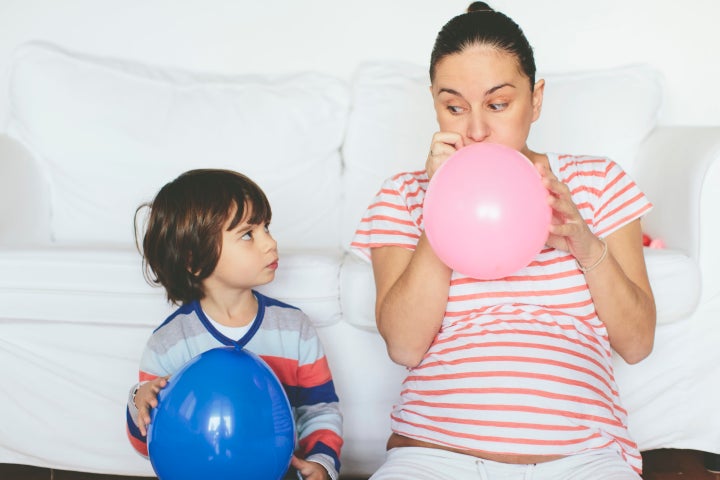Despite becoming increasingly out of fashion due to public disapproval, some expectant couples are still hosting gender-reveal events.
On the surface, it seems innocuous enough to celebrate learning an aspect of a baby’s identity. Many families begin robust discussions of gender early with children and continue them regularly, but many others don’t. For children without age-appropriate, all-encompassing gender explanations, gender reveal parties may be confusing or instill gender stereotypes and assumptions.
Toronto sexuality educator Dr. Nadine Thornton doesn’t condemn gender-reveal parties. She says when she was waiting for her child to be born, she often tried to visualize what he or she would look like, and biological gender was a part those imaginings. However, she cautions parents that gender reveals perpetuate the myth that gender identity and sexual biology are the same things.
“I think a lot of that social conditioning comes into play with gender reveals. We find out a baby has a vulva or a penis, and it feels like critical information about who that child is. In reality, we’ve learned something about their body,” Thornton told HuffPost Canada.

Education is key
If parents want their children to be inclusive, education is crucial. Guelph, Ont. mom of two Natalie Lelacheur-Romero talks to her kids about gender whenever opportunities arise. She has explained that biological body parts aren’t necessarily indicative of a person’s gender, and that gender can be fluid and change.
Lelacheur-Romero shared her nine-year-old daughter’s reaction to a gender reveal party video: “She asked why pink and blue represented female and male. I love that she’s not even sure why that’s a question. I tell my kids colours never indicate gender.”
Toronto mom-of-three sons Kat Antonopoulos works hard to ensure her children don’t subscribe to gender stereotypes. “Colours are for everyone,” is repeated often in family, and pink is her eldest’s favourite colour. She’s also discussed the stereotyping of gendering clothing, and her kids understand there’s nothing wrong with boys wearing dresses.
Keep the conversations going
Thornton encourages regular conversation with kids about gender. She recommends that in the event of an upcoming gender reveal party, parents can start by telling kids they might see a lot of pink used to celebrate a baby with a vulva, or blue to celebrate a baby with a penis.
“Ask your kids questions like, ‘Why do you think people believe certain colours are for boys or girls?’” proposes Thornton, and then, “‘What do YOU think about that?’” to hear their thoughts and understand what they’ve absorbed.
Gender-reveal parties can also be an opportunity to talk about how sometimes genitalia-based gender isn’t what a person grows up identifying with, Thornton said. Kids usually understand that some people may feel their genitalia doesn’t represent the gender they’re most comfortable living as, or the gender they want to express publicly.
WATCH: Gender can be both liberating and stifling. Story continues below.
Diana Whitney, a Brattleboro, Vt. mom of two, hadn’t discussed gender-reveal parties with her kids before she learned of a teacher at their former elementary school who held a gender-reveal event at the school and was asked to apologize for doing so.
Whitney seized the moment to initiate a conversation about gender with her children, then 11 and 13.
“We talked about how this kind of public event could be hurtful, confusing, or shaming for kids who identify as trans, non-binary or genderqueer, or who were questioning their gender identity,” Whitney explained.
“Both my daughters have had classmates who are trans or non-binary, so they understood the concept quickly, and saw why the public celebration of genitalia wasn’t appropriate. I suggested it would be different if the parents had held a private party, so guests could decide if they wanted to attend.”
How to help your kids learn about gender
For parents who are unsure how to teach kids about gender, Thornton and Sexuality Educator Fae Johnstone created excellent videos for primary-aged children, senior-elementary children and high school kids, all based on the 2015 Ontario health curriculum. There are also great books for elementary kids to learn how to be fully-inclusive of all genders, or for tween/teens.
Whitney also watches age-appropriate TV or movies with her kids that positively present gender diversity and discusses her friends and colleagues of diverse genders in ways that “normalize” or give positivity to her family’s understanding of all genders.
As for gender-reveal events, Thornton still doesn’t generalize them as bad.
“I think having hopes and fantasies about who our unborn baby might be is lovely. But I also think it’s important to acknowledge that once that baby comes into the world, they’re not a fantasy. They’re a real, complex human whose behaviour, interests, and gender may very well be different from what we’ve assumed.”
Also on HuffPost: